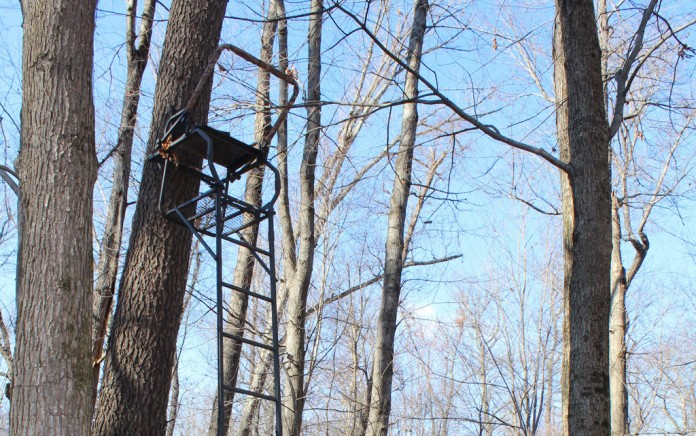A couple of weeks ago I was scrolling through my Facebook feed when I saw a short video titled “Tree stand fails.” I’m not a hunter, but anything with “fails” in the title usually gets my attention. There were some gruesome falls, some funny and all scary. But they ended with the individual getting up and walking away or groaning and then laughing.
It got me thinking. What about the guys who don’t get up or start laughing?
The danger is real
Using tree stands for hunting, no matter what type, can be dangerous.
I nearly toppled out of a permanent stand situated 30 feet off the ground when I was 14 years old. If you add the distance I climbed on top of that I was probably 40 feet up. I climbed out of the stand and into the tree to retrieve an apple and the branch under my feet snapped. I managed to grab the branch over my head in time to save myself from a nasty fall.
I remember my heart pounding in my chest, clinging to the branch and working my way closer to the trunk of the tree. I climbed back down into the tree stand without a scratch on me, but I thought a lot about what a fall like that could have meant. I was lucky.
Obviously, being a kid without adult supervision and thinking you’re bullet proof will lend itself to sketchy situations, but even with tons of experience it’s important to take precaution in tree stands.
An Ohio State University Medical Center study found that 50 percent of hunting injuries result from falls with 92 percent coming from tree stands. It also reported 59 percent of the victims suffered fractures and 18 percent of fall victims sustained closed head injuries.
Another study done by the World Journal of Clinical Cases found spinal fractures to be the most common injury from tree stand accidents with the level of injury occurring most frequently in the cervical spine — the highest segment of your vertebrae.
Stay Safe
As tree stands grow in popularity, spreading the word and utilizing safety practices is more important than ever. Here are 20 tips from the U.S. Fish and Wildlife Service and the Treestand Manufacturer’s Association.
- Only use certified equipment.
- Follow manufacturer’s instructions and warnings for using your equipment.
- Never make modifications to a manufacturer’s tree stand.
- Check your stand and harness for signs of wear or damage — cracks, loose or missing bolts, worn chains or straps and parts that have exceeded the recommended expiration date. For replacement parts, contact the manufacturer.
- Practice using your equipment at ground level before testing it out in the field.
- Select a healthy, straight tree without insects or animal dens that sits straight and is the right size for your stand. Do not use climbing stands on trees with smooth bark.
- Clear debris from under the stand to minimize injury if you fall and to make a safe base for if you’re using a ladder stand.
- Never exceed the tree stand weight limit as outlined by the manufacturer.
- Wear a Full Body Fall Arrest Harness System that meets or exceeds industry standards outlined by the Treestand Manufacturer’s Association, while ascending and descending. The use of single strap belts and upper-body only harnesses can result in injury or death.
- Make sure your harness is attached to the tree before you start climbing.
- When climbing a ladder keep three points of contact at all times — two hands and a foot or two feet and a hand.
- When using a platform stand climb higher than the stand and step down onto it slowly.
- Wear boots with non-slip soles.
- Use a haul line to raise your gear into the tree stand rather than climbing up with it on your person and lower it down before you descend. Never carry equipment when climbing. Make sure firearms are unloaded and broad heads are covered before attaching to the haul line.
- Keep your harness tether line as short as possible with no slack when seated to minimize the distance in case of a fall.
- Have a plan in place. Let someone know where you’ll be, who’s with you and when you’ll return.
- Keep your cell phone, a whistle and a flashlight in a sealed pocket.
- In the event of a fall, follow the three R’s — recover, relief and rescue. Attempt to recover and return to your stand. If you are unable, exercise your legs by pushing against the tree or using your suspension relief device until help arrives.
- Never leave a tree stand installed for more than two weeks.
- Know your limitations, take your time.











